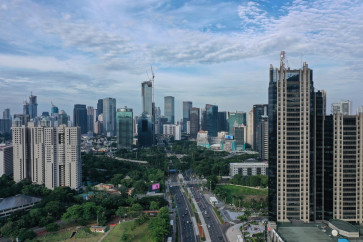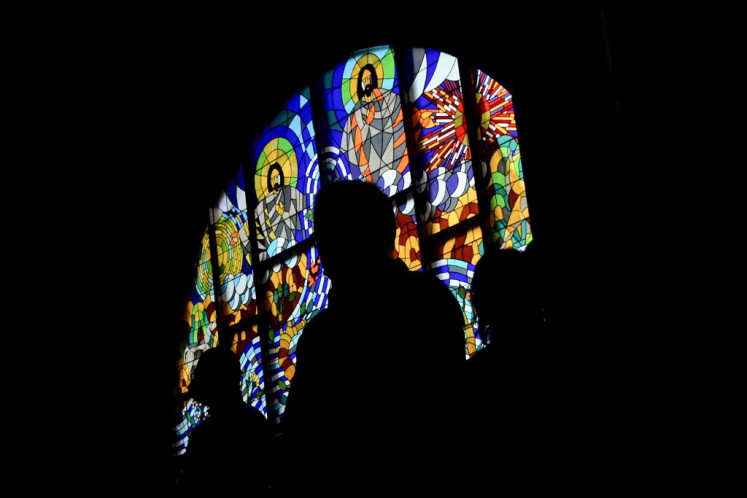Popular Reads
Top Results
Can't find what you're looking for?
View all search resultsPopular Reads
Top Results
Can't find what you're looking for?
View all search resultsLosing faith
Karangpandan templeItâs one of Indonesiaâs many great mysteries: Why and how did a religion that once flourished widely almost disappear â and so rapidly?The obvious answer is a war with the losers fleeing, but historian Wayan Legawa, father of Brawijaya University cultural studies lecturer Wayan Swardhani Wiraswastiningrum, disagrees
Change text size
Gift Premium Articles
to Anyone
Karangpandan temple
It's one of Indonesia's many great mysteries: Why and how did a religion that once flourished widely almost disappear ' and so rapidly?
The obvious answer is a war with the losers fleeing, but historian Wayan Legawa, father of Brawijaya University cultural studies lecturer Wayan Swardhani Wiraswastiningrum, disagrees.
'There was no clash, no battle between Islam and Hinduism,' said the Malang State University academic. 'The exodus to Bali was more political. It involved disputes in the royal family of the Majapahit kingdom centered around Trowulan in East Java.'
Some of the priests, he said, went further east as the families fractured and the people followed. 'They included the descendants of the ancient households, like the Tenggerese now farming the slopes of Mount Bromo,' Wayan said.
The Tenggerese population is reported to be about 600,000, though some have converted to Islam and Christianity.
Not all made it across the Bali Strait. The Osing people in Banyuwangi on the far south-east coast of Java also claim Majapahit ancestry. The population is around 400,000 though not all are Hindu.
A supporting theory is that the decline of Hinduism and Java's Golden Age began after the 1364 death of Gadjah Mada. His Machiavellian political and military skills helped the empire conquer and control the archipelago across to Timor, and lands beyond Java, into present day Malaysia and the Southern Philippines.
Once Gadjah Mada's funeral pyre had cooled civil wars weakened the kingdom allowing vassal states to recover their independence and embrace a new religion.
Dr. Wayan believes there are around eight million Hindus in Indonesia. Outside Bali most live in East Java.
'The position of Hindus in Indonesian society is that there's been little change socially, though in dealings with authorities the situation has improved,' he said.
'Relationships between the faiths deteriorated after 1974 when the Soeharto government banned mixed-faith marriages. That's still in place and it has affected all religions.'
The question that's usually whispered rather than shouted is its potency: Is Hinduism on the way back?
The 12th century Javanese soothsayer Joyoboyo predicted a return; if it's underway the pace is pedestrian and the evidence patchy. Measured against the strides of Islam and Christianity, Hinduism seems almost stationary.
Even if the figure of eight million is accepted, that's still less than five percent of the Muslim population.
Outside Bali, the world's third most followed religion has its best toehold in East Java, with shrines, temples and primary schools in places like Gresik, Kediri and Surabaya.
Santika Dharma is a small high school opened five years ago in the forest outside Malang. It caters for around 120 students and is still the only Hindu school in Java.
Principal Ketut Sudhiartha said getting a building permission had taken a long time though few people lived nearby. The school is close to the well-hidden Pura [shrine] Luhur Dwijawarsa on the western side of Semeru, the highest mountain in Java and an important spiritual landmark.
Luhur Dwijawarsa was built during the late 1950s. It was attacked by arsonists following the 1998 fall of president Soeharto. At the time churches were also burned. Outhouses were destroyed but the community has rebuilt itself and has not pursued action, preferring to let the issue drop for the sake of religious harmony.
After Majapahit's collapse, temples like the world-famous 9th century complex at Prambanan in Central Java, and the 12th century Penataran in East Java, fell into disrepair. They were looted and overgrown until they were rediscovered in the 19th century.
Not all old temples are suitable for worship because many have become tourist sites, so Hindus have been building new spaces for prayer. In 2006, an 11-meter high temple, claimed to be the tallest in Java, was opened in the village of Karangpandan near Malang, in an area where most people follow Islam and mosques are common.
A Hindu primary school runs behind the temple. Kampung Topeng, the village next door, is the center of East Java's mask-dancing and carving ' a tradition which pre-dates the arrival of Hinduism. If there is fundamentalism and hostility to pluralism, it's not evident here.










